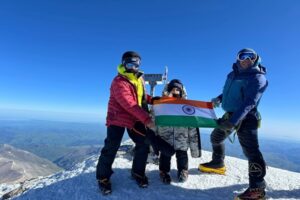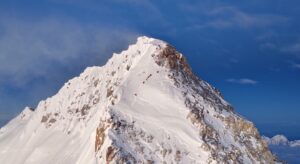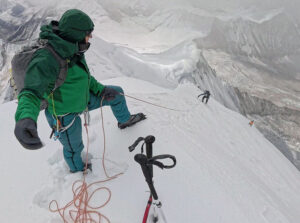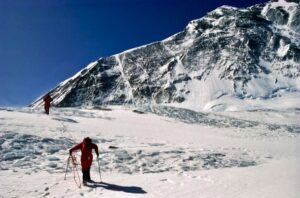To switch on the O2 or to call off the attempt, that is the question.
Carla Perez spent eight days going up to the higher camps on Makalu, then down again. She never went lower than Camp 1. When Perez heard that May 12 would be a good summit day, she thought: Well, why not try it without oxygen?
Well, because of the cold, actually. Climbers become a lot colder without oxygen.
“The cold was so bitter just before sunrise that I couldn’t stop shivering, not even while moving up,” she said. At 8,250m, just 200m below the top, she knew she had to make a decision or face frostbite.

Carla Perez on Makalu. Photo: Instagram
“Those who were trying without O2 turned to the bottled gas. And in some cases, even that was not enough,” Perez said, “because they ended up with frostbite. I could have done the same but I told myself: Why are you then proposing challenges to yourself [she intends to climb the world’s five highest mountains without O2] if when the time comes, you return to the easy, guaranteed option?”
Perez stuck to her original plan. She didn’t use oxygen but she turned around, together with two no-O2 Italian climbers who had made the same choice. (She didn’t mention their names).
Carla Perez is no novice at climbing big peaks the hard way. She has summited Everest, K2, Cho Oyu, and Manaslu, all without O2. She only used oxygen when guiding on a second Everest expedition.
Now, she waits for another summit chance. According to Kris Annapurna, out of the 568 Makalu ascents (until 2021), only 45 were women. Among female summiters, just 16 have done so without O2.

Billi Bierling on Dhaulagiri some days ago. Photo: Billi Bierling
Dhaulagiri is bigger without O2
“Dhaulagiri is such a big mountain, it’s out of my league,” Billi Bierling told ExplorersWeb while waiting for a plane back to Kathmandu.
Bierling is not just a member of The Himalayan Database team. Like Perez, she is experienced, with six 8,000’ers under her belt. It suggests that Dhaulagiri is out of many climbers’ leagues, depending on the criteria applied.
Here, Bierling was climbing with a heavy backpack and without oxygen. “I had nothing left in me,” she said. “Not an inch of energy. I might have made it up, but I would have got into trouble on the way down.”
She had set out to do it without O2 or not at all, so like Perez, she turned back. “But I so take my hat off to my fellow climbers who summited!” she said.
In fact, five members of her team, outfitted by Kari Kobler, reached the top without supplementary O2 — Karma Gyalzen, Tashi Chhirring, Mingmar Sherpa, Jonas Salzmann, and Jurgen Diez. That is an unusually high percentage these days among commercial groups, even on “lower” 8,000’ers such as Dhaulagiri (8,167m).
Psychological O2
Like nearly everything in climbing, choices are personal and criteria are wide. All should be acceptable as long as they are clear. Every year, climbers on the biggest peaks, such as Everest and K2, announce that they “may try without O2”. In fact, they have O2 cans and masks stored in higher camps “just in case”, or even in the backpack of their assisting Sherpa.
This allows them to switch to the safest option in case the challenge is tougher than expected. It’s what many veterans call “psychological O2”.
“You try and force yourself to the limit because you know there is an O2 safety guarantee ready for you,” ExplorersWeb founder Tom Sjögren used to say during discussions with fellow Everest climbers.

A climber masked up at Everest’s South Col. Photo: Climbing The 7 Summits
Indeed, having O2 somewhere at hand is a very helpful option when you face the decision of whether to push ahead or retreat.
Climbers rarely mention that they had this choice at hand. If everything turns out well, they just claim a no-O2 ascent. Still, the question remains: If the oxygen canisters stay in the backpack, but are there to use the moment the going gets too tough, can it really be considered a no-O2 climb?
O2 dosage
There are several ways of using oxygen during a climb: from brief bursts only to only during the night to sleep better to the maximum 8L/minute flow rate. All of these, no matter how minor the usage, qualify as O2-assisted climbs.
This is also true for climbers who suffer altitude sickness or frostbite and need medicinal O2. Juanito Oiarzabal is an example. Badly frostbitten after losing his way between the summit and Camp 4 on K2 in 2004, he wouldn’t let his worried partners put an oxygen mask on his face. Oiarzabal stubbornly wanted to keep his O2-free ascent, despite the risk. In the end, he finally accepted oxygen after his partners had to help him down to Camp 3.

Nico Miranda (left) and Karl Egloff on Makalu. Photo: Karl Egloff
Obvious as it may seem, it must (again) be noted that a no-O2 climb means going both up and down the mountain without supplementary gas. Karl Egloff sped up Makalu last week in an amazing 17 hours 18min from ABC to summit, without oxygen. But he was not prepared for the hardships of descending. Both he and partner Nico Miranda said that the way down was by far the worst part of the climb. In the end, they managed, but many have not. The history of high-altitude mountaineering is rife with fatalities during the descent.
Beware the way down
Egloff and Miranda’s experience is not unusual. The effects of thin air — and thus the temptation to use bottled gas — is often worse on the way down. Horia Colibasanu (10 8,000’ers without O2, including Kangchenjunga a week ago) told ExplorersWeb that climbers try their best to reach the summit. Once they’ve achieved the goal, they find themselves utterly exhausted, without the carrot of the summit to drive them. Typically too, darkness is looming and they face a long, often lonely descent since those using oxygen are much faster.
Hence the importance of Carla Perez and Billi Bierling‘s decisions. For both, the calculus was not about whether they might be able to reach the top without O2. It was about what could happen on the way down.

Horia Colibasanu, gasping in the thin air on Kangchenjunga’s summit, May 7, 2022. From Horia Colibasanu’s summit video
Horia Colibasanu, who summited Kangchenjunga without oxygen just last week, notes that a no-O2 climb requires a strategy that is different from that of an O2-assisted ascent.
“We usually set off later, in order to spend less time in the cold night,” he says. “But then we must keep to a strict deadline. We cannot afford to take too long to the summit or to get there too late in the day. We can’t afford to be up there as night falls again.”
No-O2 climbs must be carefully coordinated among all members of the team, especially if not everyone is climbing the same style.
Different strategies
In recent years, very long summit pushes have taken place, often from lower camps. The whole climb also takes many fewer days. Extremely early summits are also becoming the norm for fast climbers and teams trying to avoid crowds. These strategies usually depend on plenty of oxygen.
Likewise, high-altitude guides typically climb with O2, because they need to look after not only themselves but their clients. When Mingma Dorchi spoke with ExplorersWeb for our Climbing Guide to Makalu, he explained that he has summited the mountain three times, always with oxygen, because he has been always guiding clients.
On the other hand, when Mingma G made his second (and ultimately successful) attempt on Winter K2, he declined the “burden” of bringing clients along. He said he couldn’t take care of them if he decided to attempt the mountain without O2.
In the past, there have been different opinions on this matter. After the 1996 Everest tragedy, Anatoli Boukreev — guiding for Mountain Madness — was criticized for refusing to use bottled O2. But the excellent Kazakh climber argued that he could not afford to have a problem with the O2 system or to run out of gas at 8,000m — a rather common occurrence in those years.
In the past, Sherpas and high-altitude porters usually didn’t use gas, especially on the lower 8,000’ers, because everyone typically climbed without it. Everest was always different: Both Nepalis and foreigners have used oxygen on it since the beginning.

Chhepal Sherpa on the summit of Lhotse, with clients, yesterday. Photo: Chhepal Sherpa
Nowadays, however, technology has improved, supplies of bottled oxygen are almost endless, and there are multiple ways to shuttle even more to high camps if necessary. The no-O2 option remains for those wanting to climb that way for aesthetic or ethical reasons.
Sherpas — and to some extent, other high-altitude mountain peoples around the world — are comparatively faster without O2 than the rest of us. Aided by supplementary O2, they are powerhouses. It is likely that many of them could climb without O2 if they chose to do so.
How much slower is a no-O2 climber?
“In my case, on average, I’d say that during a five to six-hour climb on an 8,000’er, I’d need one more hour [without oxygen],” Colibasanu suggests. This depends, of course, on the climber, his condition, and the mountain’s condition at the time.
Could an extremely strong climber keep the same pace as climbers on O2? Again, that depends greatly on the no-O2 climbers, and most of all, on the climbers using O2. With inexperienced, less fit people, supplemental oxygen can’t work miracles.
According to Colibasau, among regular climbers, the use of O2 makes a remarkable difference in every case. “The time difference may vary, but you simply do not climb at the same speed,” said Colibasanu. “I have climbed with Kilian Jornet — and Kilian is mind-blowingly fast, let me tell you — but he is human too. Stories about ‘supermen’ are better left for movies.”






